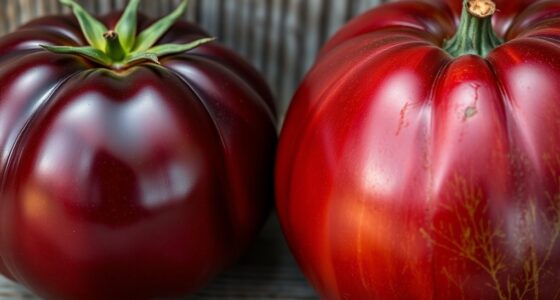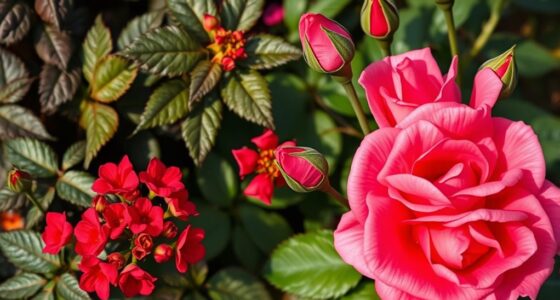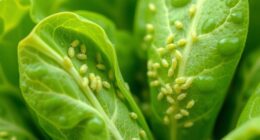La Dreamin hydrangeas maintain a more consistent bloom color, with less variation based on soil pH, usually displaying vibrant pinks and purples. Endless Summer offers a broader color range, changing from blue in acidic soil to pink in alkaline conditions, with seasonal shifts enhancing their appeal. Regarding durability, Endless Summer thrives in zones 4-9, making it suitable for colder climates. If you want a detailed comparison of their color versatility and climate adaptability, keep exploring their features further.
Key Takeaways
- La Dreamin Hydrangea maintains a consistent color palette, less influenced by soil pH, while Endless Summer offers a wide color spectrum from blue to pink.
- Endless Summer hydrangeas are hardy in USDA zones 4-9, thriving in colder climates, whereas La Dreamin prefers specific zones matching its climate requirements.
- Soil pH can be adjusted to shift Endless Summer’s bloom colors, but La Dreamin’s color remains relatively stable regardless of soil chemistry.
- Both varieties perform well in moist, well-drained, slightly acidic soils, but Endless Summer’s color variation is more soil-dependent.
- La Dreamin emphasizes vibrant, fragrant blooms with less seasonal color change, while Endless Summer exhibits more dramatic seasonal color shifts.
Overview of La Dreamin Hydrangea

The La Dreamin Hydrangea stands out for its striking color variations and compact growth habit. Its flowers emit a subtle, pleasant fragrance that enhances its appeal in any garden. To keep it healthy and flowering abundantly, you’ll want to master pruning techniques; this involves removing dead or crossing stems in late winter or early spring. Proper pruning encourages new growth and maintains its dense, rounded shape. Unlike some hydrangeas, La Dreamin responds well to light pruning, which helps preserve its vibrant flower color and overall vigor. Regular maintenance ensures the plant stays manageable and continues to produce its attractive blooms. Additionally, understanding gardening basics can help you optimize its care and ensure a thriving, beautiful plant. For example, providing the right amount of water and sunlight is crucial for its development. With attentive pruning and an eye on flower fragrance, you’ll enjoy a lush, colorful display from this charming hydrangea.
Overview of Endless Summer Hydrangea

The Endless Summer hydrangea offers a stunningly wide color spectrum that can change from season to season. It’s also known for its resilience in cold climates, making it a reliable choice for cooler areas. If you’re looking for vibrant blooms that withstand harsh winters, this variety might be just what you need. Additionally, understanding foraging techniques can help gardeners identify and select robust plants suited for diverse environments. Proper plant care can further enhance its durability and flowering performance in various climates. Moreover, selecting hardy varieties that thrive in specific zones can optimize growth and longevity.
Wide Color Spectrum
Endless Summer hydrangeas are renowned for their remarkable ability to change color, offering a wide spectrum that can range from vibrant blues and pinks to purples and even greenish hues. This color variation depends heavily on soil pH preferences; acidic soils produce blue flowers, while alkaline soils yield pinks. To optimize color, you can adjust soil acidity with amendments like sulfur or lime. Pruning techniques also influence bloom color and size, as proper pruning encourages healthy, vibrant flowers. Regular pruning encourages new growth, which is essential for maintaining the plant’s ability to produce colorful blooms. Understanding how soil pH and pruning methods affect your hydrangea can help you better control its color spectrum and enjoy a stunning display throughout the season. Additionally, soil testing can help you accurately determine your soil’s pH level, allowing for more precise color management. Moreover, knowledge of plant physiology can enhance your ability to optimize flowering results and overall plant health. Proper watering practices also play a vital role in maintaining the health and vibrant coloration of your hydrangeas.
Cold Climate Resilience
Building on the vibrant color variations of Endless Summer hydrangeas, their adaptability extends beyond soil chemistry to withstand colder climates. These hydrangeas are known for their impressive cold hardiness and winter resilience, making them suitable for USDA zones 4 through 9. You’ll find that they can endure freezing temperatures and snow without significant damage, often rebounding strongly in spring. Their ability to survive harsh winters without extensive protection sets them apart from other hydrangea varieties. Proper planting location and mulching can further boost their resilience. Additionally, ongoing automation technology developments in horticulture are enhancing plant monitoring and care, supporting their hardiness in challenging conditions. Cold climate resilience is further reinforced by their capacity to adapt to various microclimates within colder regions. The hardiness zone ratings help gardeners select varieties that will thrive in their specific climate zones. If you live in a colder region, Endless Summer hydrangeas provide a reliable choice for year-round garden beauty, offering vibrant blooms and dependable performance despite winter challenges.
Bloom Color Variations and Range

Hydrangeas showcase an impressive spectrum of bloom colors that can vary widely even within the same species. Your flower color potential depends heavily on soil pH, which influences whether blooms turn blue, pink, or purple. Both La Dreamin Hydrangea and Endless Summer offer a broad color range, but their shade tolerance differs. Endless Summer, for example, can produce vibrant blues in acidic soil and pinks in alkaline conditions, showcasing its adaptability. La Dreamin tends to have a more consistent color palette, with less variation based on soil pH. Understanding these bloom color variations helps you select the right variety for your garden’s aesthetic and soil conditions. This color versatility is what makes hydrangeas such popular, eye-catching plants.
Seasonal Color Changes and Longevity

Seasonal changes considerably influence the color display and lifespan of hydrangea blooms. As temperatures fluctuate throughout the year, you’ll notice seasonal color shifts that can deepen, fade, or even change hue. For example, some hydrangeas develop richer colors in cooler weather, while others may fade faster as temperatures rise. Understanding these patterns helps you predict bloom longevity and plan your garden accordingly. Proper soil pH, sunlight, and watering practices also impact how long your blooms last and how vibrant their colors stay. Additionally, juicing techniques can reveal how plant health influences bloom quality and longevity. Paying attention to seasonal cues and how they affect plant growth can help you optimize your hydrangeas’ performance. Recognizing the importance of watering practices can further enhance bloom longevity and color vibrancy. By paying attention to seasonal cues, you can enhance your hydrangeas’ visual appeal and extend their bloom longevity. Embracing these natural variations allows you to enjoy a dynamic, colorful display year-round.
Hardiness Zones and Climate Adaptability

Understanding your garden’s hardiness zone helps ascertain which hydrangeas will thrive. Climate adaptability factors, like temperature extremes and humidity, influence how well a plant performs year-round. Knowing these points ensures you select varieties suited to your environment, leading to healthier, more vibrant blooms. Additionally, selecting plants that align with your fathers’ influence and character can foster a more harmonious garden environment. Recognizing the importance of climate resilience can further assist in choosing hydrangeas that will flourish despite changing weather patterns. Being aware of your local climate conditions can help you make more informed decisions for long-term garden success.
Zone Compatibility Overview
To thrive in your garden, it’s vital to match hydrangea varieties with your local climate’s hardiness zone. Knowing your zone helps determine which hydrangeas will survive and flourish year-round. Both La Dreamin and Endless Summer prefer specific soil pH preferences—acidic soils produce bluer blooms, while alkaline soils turn flowers pink. Make sure your soil pH aligns with your desired color outcome. Additionally, pruning techniques vary by zone; in colder areas, you’ll want to prune lightly to protect buds, while in milder zones, more vigorous pruning encourages better flowering. Understanding your zone’s temperature ranges and seasonal changes ensures you select the right hydrangea and manage it properly, maximizing its performance and durability throughout the year.
Climate Adaptability Factors
Matching hydrangea varieties to your local climate involves more than just soil pH and pruning techniques; it also requires considering their ability to withstand your area’s temperature and seasonal conditions. Hardiness zones help determine which hydrangeas can survive your winters, so check your zone before planting. Climate adaptability also depends on understanding their soil preferences—some thrive in well-drained, moist soil, while others prefer slightly acidic conditions. Additionally, watering needs vary; hydrangeas in hotter climates may require more frequent watering, especially during dry spells. Ensuring your chosen variety can handle temperature fluctuations and seasonal changes will promote healthy growth and vibrant blooms. Climate adaptability encompasses the plant’s resilience to temperature swings and seasonal shifts, which is crucial for long-term success. By matching these climate factors, you set your hydrangeas up for success and long-lasting beauty.
Growing Conditions and Care Requirements

Hydrangeas thrive when they’re planted in well-draining soil that stays consistently moist but not waterlogged. They prefer soil rich in organic matter with a slightly acidic to neutral pH, which enhances their vibrant blooms. Regular watering is essential, especially during hot, dry periods, but avoid overwatering to prevent root rot. Keep the soil evenly moist, and consider mulching to retain moisture and regulate temperature. Both La Dreamin Hydrangea and Endless Summer need a balanced watering schedule to promote healthy growth and abundant flowering. Make certain they’re planted in a location with morning sun and afternoon shade to protect from intense heat. Proper soil preferences and consistent watering needs are key to keeping your hydrangeas healthy and thriving. Additionally, understanding remote work productivity strategies can help gardeners find time to tend to their plants even during busy schedules. To further support healthy growth, selecting appropriate soil amendments can improve soil structure and fertility.
Pest and Disease Resistance

Both La Dreamin Hydrangea and Endless Summer demonstrate strong resistance to common pests and diseases, making them reliable choices for gardeners seeking low-maintenance plants. Their pest resistance means you’re less likely to deal with issues like aphids or spider mites, reducing the need for chemical treatments. Additionally, their disease tolerance helps prevent problems such as leaf spot or powdery mildew, even in humid conditions. This resilience allows you to enjoy vibrant blooms without constant monitoring or intervention. While no plant is completely immune, these hydrangeas are particularly hardy, giving you peace of mind and saving time on maintenance. Overall, their robust pest resistance and disease tolerance make them ideal options for a stress-free, beautiful garden.
Visual Impact Throughout the Year

Throughout the year, hydrangeas like La Dreamin and Endless Summer deliver stunning visual impact with their dynamic color changes and lush foliage. Their evolving blooms add vibrancy to your flower arrangements and landscape design, ensuring year-round interest. Imagine:
- Bright, pastel flowers in summer, perfect for fresh bouquets or focal points.
- Mellow, muted tones in fall, blending seamlessly into autumn landscapes.
- Rich, deep hues in winter, providing contrast against bare branches and evergreen shrubs.
These hydrangeas transform your garden into a visual masterpiece, whether planted in borders or used as container specimens. Their consistent color shifts and dense foliage keep your landscape lively and engaging through every season, making them essential for maintaining beauty and interest in your outdoor spaces.
Making the Right Choice for Your Garden

Choosing the right hydrangea for your garden depends on your specific climate, aesthetic preferences, and maintenance style. Consider soil preferences—some hydrangeas thrive in well-draining, slightly acidic soil, while others prefer more alkaline conditions. Also, think about pruning techniques; Endless Summer hydrangeas bloom on both old and new wood, so they require moderate pruning, whereas La Dreamin hydrangeas need minimal pruning to maintain their shape. If you want vibrant color changes and easy care, Endless Summer might suit you best. If you prefer a more natural look with less maintenance, La Dreamin could be ideal. Assess your garden’s conditions and your willingness to prune regularly to make an informed choice that guarantees your hydrangeas flourish and enhance your landscape.
Frequently Asked Questions
Which Hydrangea Variety Is More Drought-Tolerant?
You might wonder which hydrangea variety shows better drought resistance. Generally, Endless Summer hydrangeas tend to have lower water needs, making them more drought-tolerant than some other types. They adapt well to periods of dryness, but you should still provide occasional deep watering to keep them healthy. La Dreamin hydrangeas, on the other hand, prefer consistent moisture, so they require more regular watering for ideal growth.
Can Both Hydrangeas Be Grown in Containers Successfully?
You can successfully grow both hydrangeas in containers by focusing on proper container cultivation. Make certain you select pots with good drainage and use soil requirements like well-draining, rich, and slightly acidic soil. Regular watering is essential, especially during dry periods. Both varieties thrive in containers if you monitor moisture levels, provide adequate nutrients, and protect them from extreme weather. This way, you’ll enjoy vibrant blooms all season long.
Are There Any Specific Fertilizers Best Suited for These Hydrangeas?
You should focus on fertilizer recommendations that meet your hydrangeas’ plant nutrient needs. Use a balanced, slow-release fertilizer with equal parts nitrogen, phosphorus, and potassium in spring and early summer. For vibrant blooms, a fertilizer higher in phosphorus can help. Avoid over-fertilizing, which can harm the plant. Regular feeding guarantees your hydrangeas get the essential nutrients they need to thrive, especially when grown in containers where nutrients wash out more quickly.
How Do These Hydrangeas Perform in Shady Versus Sunny Locations?
When considering shade tolerance and sun exposure, you notice how these hydrangeas perform differently. In shady spots, they thrive with less risk of leaf scorch, offering lush foliage and vibrant blooms. Under full sun, they may need extra watering but can produce more intense flower colors. Both types adapt well to a range of light conditions, but understanding their sun exposure needs guarantees you optimize their growth and flowering potential.
Do Either of These Hydrangeas Attract Pollinators or Wildlife?
You’ll be pleased to know that both hydrangeas support pollinator attraction and wildlife support. They produce large, vibrant flowers that attract bees, butterflies, and hummingbirds, helping to sustain local pollinators. These plants provide nectar and shelter, making your garden more lively and eco-friendly. By planting either of these hydrangeas, you actively contribute to supporting pollinators and wildlife, creating a thriving, vibrant garden environment.
Conclusion
Choosing between La Dreamin and Endless Summer hydrangeas is like selecting a loyal companion for your garden’s journey. Both bring vibrant colors and resilience, symbolizing growth and beauty through changing seasons. Trust your instincts and envision how each will bloom and thrive alongside you. With either, you’re planting more than flowers—you’re cultivating a lasting memory, a living proof to nature’s enduring artistry that will brighten your days for years to come.









